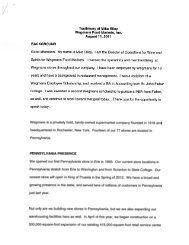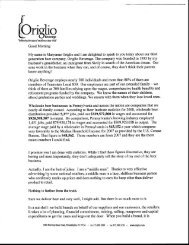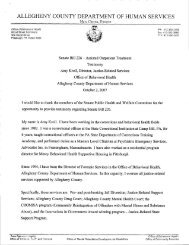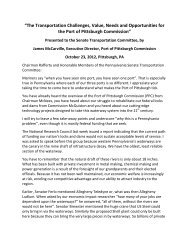August 17, 2010 – 1:00 PM North Office Building, Hearing Room ...
August 17, 2010 – 1:00 PM North Office Building, Hearing Room ...
August 17, 2010 – 1:00 PM North Office Building, Hearing Room ...
- No tags were found...
You also want an ePaper? Increase the reach of your titles
YUMPU automatically turns print PDFs into web optimized ePapers that Google loves.
Background<br />
Drack Testimony <strong>–</strong> <strong>August</strong> <strong>17</strong>, <strong>2010</strong><br />
I believe I am qualified to testify on these matters in that I not only received an ENRADD citation which<br />
I believe to have been in error by more than 16 mph, but I am also an engineer and engineering manager<br />
with over 25 years experience in the design and test of precision measurement instrumentation,<br />
primarily for the petroleum industry. My education includes a master’s degree in Electrical Engineering<br />
from Cornell University and an MBA from the Wharton School of Business.<br />
I have no outstanding ENRADD citations, having been found not guilty in court, and do not offer any<br />
competing products, and am here simply to see that all Pennsylvanians and visitors to our state are<br />
treated fairly. It was my own citation and my concern as to how an approved device could have given<br />
such a large error that got me looking into this matter, and the more I learned the more I felt compelled<br />
to get these problems addressed so others could avoid an unfair citation and all the associated hassle and<br />
financial penalties. In particular, those motorists who drive for a living and must maintain a clean<br />
driving record are most vulnerable to grossly unfair outcomes.<br />
ENRADD Approval Issues:<br />
As you may be aware, all non-radar devices must be approved by PennDOT before they can be used as<br />
the basis for a citation, and PennDOT has a written procedure for such approval (see attached Figure 1<br />
for the procedure in place at the time the wireless ENRADD EJU-91 was approved in <strong>August</strong> of 2<strong>00</strong>3).<br />
When I first was able to see this procedure the problem was clear <strong>–</strong> instead of PennDOT performing its<br />
own critical and objective technical analysis and testing of a device, they allow the device manufacturer<br />
to specify what testing is (and is not) done. While PennDOT does choose an independent lab to perform<br />
the testing, that lab does only what testing the manufacturer tells it to do. And while PennDOT is<br />
required by its own written approval process to review the testing that was done and issue an<br />
approval/denial report, in this case that step was not performed, and it is not clear whether PennDOT<br />
even has someone qualified to do such a technical review and analysis. What’s more, PennDOT says it<br />
has no record of a written instruction that the wireless ENRADD be included in the PA Bulletin list of<br />
approved devices. It is therefore unclear, even now, on what basis and on whose authority the<br />
wireless ENRADD EJU-91 was approved and how it came to show up on that list.<br />
2
















